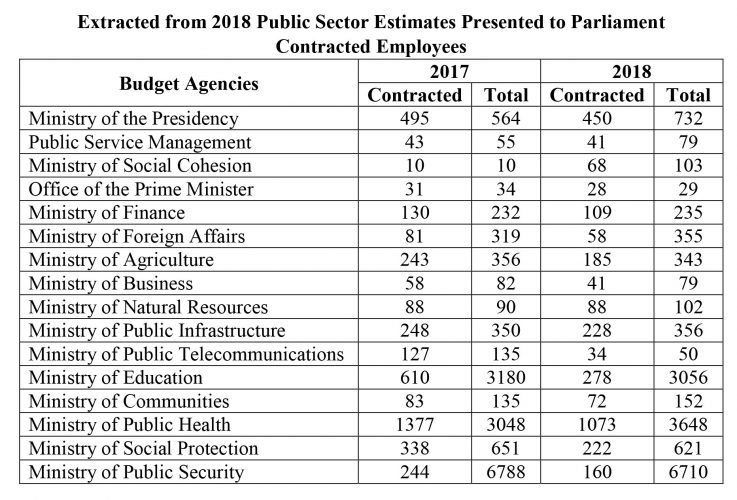Dear Editor,
The first paragraph of Chapter 2 of the CoI Report into the Public Service reads as follows:
Among the issues brought to our notice during our enquiry as needing to be addressed, was the significant number of persons occupying positions in the Public Service, who were not recruited through the established processes and procedures of the Public Service Commission. These “contract employees” are estimated to be sizeable percentages of the workforce of Ministries and Departments at all levels of their operations to the extent that their presence is at times represented as constituting a parallel public service in conflict with the official Public Service. However, contrary to this claim there is the assertion that contract employees are usually needed to both supplement, complement and augment skills deficit in the public bureaucracy.
This notwithstanding, the Public Sector 2018 Estimates presented to Parliament reveals, amongst others, the following numbers in respect of ‘Contracted Employees’.
Amongst the comments the Report made on the situation are the following extracts:
105. According to our understanding, the reference to contract employees is to recruitment and appointment of persons to established posts in the Public Service to serve for fixed and limited periods of time at the end of which their contracts are either renewed (extended) or ended, which is unlike the situation that obtains when persons are appointed to permanent positions in the traditional Public Service.
110. But, in practice, it has proved exceedingly difficult to adhere to this posture in the presence of dominant political elements in Guyana and the resulting reality that governments tend to prefer to have in place not neutral or neutered public servants but those who are among their enthusiastic and active supporters. Once this pattern is established it is, in practice, difficult to eradicate, modify or change.”
112. By way of illustration, activities and testimonies which were received have disclosed facts which are in vindication of this conclusion. The first is that contract employees tend to be appointed outside of the jurisdiction of the Public Service Commission thereby avoiding the inputs of the latter in making appointments to the Public Service. However, information available to us revealed that, at any rate, it is often possible for the predetermined choices of the Executive to prevail because the role of the Commission may be one akin to that of a post office with the former automatically attaching its approval to the names presented to it.
115. … it is obvious that it is possible for cases to exist where certain skills may be needed in the Public Service which are not possessed by persons employed within its ranks. Then, it is understandable that they may have to resort to persons outside of the Public Service possessing those skills who could then be employed on contracts with specific terms by the PSC. But even in such circumstances clear rules would be needed to ensure that interested persons who possess the requisite qualifications are provided with fair chances to compete with others for appointment. It is for such reasons that there is advocacy for such vacancies to be adequately advertised and filled in a professional manner. These requests should by no means be regarded as unreasonable or disproportionate as, according to the Constitution of Guyana, persons are entitled to fair and equal treatment.
117. Viewed in the quest to build a career and professionally driven Public Service with the optimum levels of staff, it is obvious that there must be of necessity be a requirement that all employment for Public Service positions be done by the PSC or under its aegis. The optimum complement of suitably qualified staff for each ministry, office, division, department, etc. with the right organisational needs to be evaluated and determined through human resource and organisational reviews and audits. This would identify the number of suitably qualified, experienced and skilled person for each position and identify organisational structures and lacunae in human resources thereby helping to eliminate arbitrary resort to the employment of contract employees.”
Finally the Report made the following recommendations.
Recommendations 13-16
13. That contract workers on all grades holding Public Service positions be absorbed into the pensionable Public Service establishment provided that they are suitably qualified to fill established positions.
14. That contracted employees/workers should be restricted to high level professional skills not available in the Public Service, and should be recruited and selected through open competition to obtain the best available candidates in the job market.
15. That no Public Servant who retires before attaining the age of 65 years should be employed on contract in view of the proposed age of retirement on attaining 65 years of age.
16. That the optimum complement of suitably qualified staff for each ministry, office, division, department and unit, etc., with the right organisational structure, needs to evaluated and determined by human resource and organisational audits.
The question some may ask is: when is the Report going to be read?
Yours faithfully,
E B John











